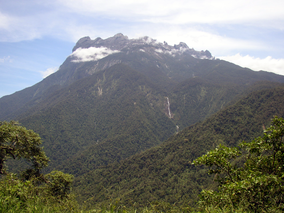Our website is made possible by displaying online advertisements to our visitors.
Please consider supporting us by disabling your ad blocker.
Kinabalu Park
| Kinabalu Park | |
|---|---|
 | |
| Location | Sabah, Malaysia |
| Nearest city | Kota Kinabalu, Tuaran (Tamparuli), Kota Belud, Ranau |
| Coordinates | 6°09′N 116°39′E / 6.15°N 116.65°E |
| Area | 754 km2 (291 sq mi) |
| Established | 1964 |
| Visitors | 611,624 (in 2010) |
| Governing body | Sabah Parks |
| Official name | Kinabalu Park |
| Type | Natural |
| Criteria | ix, x |
| Designated | 2000 (24th session) |
| Reference no. | 1012 |
| Region | Asia-Pacific |
Kinabalu Park (Malay: Taman Kinabalu), established as one of the first national parks of Malaysia in 1964, is Malaysia's first World Heritage Site designated by UNESCO in December 2000 for its "outstanding universal values" and the role as one of the most important biological sites in the world with more than 4,500 species of flora and fauna, including 326 bird and around 100 mammal species,[1] and over 110 land snail species.[2]
Located on the west coast of Sabah, Malaysian Borneo, it covers an area of 754 square kilometres surrounding Mount Kinabalu, which at 4,095.2 meters, is the highest mountain on the island of Borneo.
The park is one of the most popular tourist spots in Sabah and Malaysia in general. In 2010, the park received 611,624 visitors, including 47,613 climbers.[3]
The site has been identified by UNESCO as a Centre of Plant Diversity for Southeast Asia, as it contains representatives from at least half of all Borneo’s plant species and is extremely rich in species with elements from China, Australia, the Himalayas, Malaysia and pan tropical floras.[4]
- ^ Chilling out in a tropical destination Archived 23 May 2016 at the Wayback Machine. The Jakarta Post, 12 June 2011.
- ^ Liew, T.S., M. Schilthuizen & M. Lakim, 2017. The determinants of land snail diversity along a tropical elevational gradient: insularity, geometry, and niches. Journal of Biogeography, 37: 1071-1078
- ^ "Annual Report 2010". Sabah Parks. pp. 108–114. Retrieved 26 May 2021.
- ^ "Kinabalu Park". UNESCO World Heritage Centre. Retrieved 9 August 2021.
Previous Page Next Page



